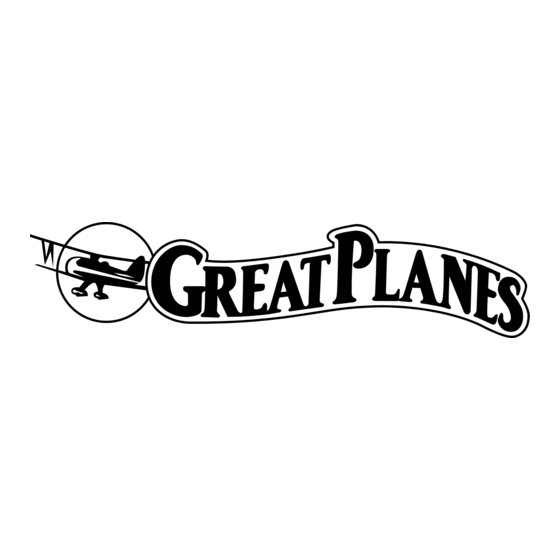GREAT PLANES YAK-55M Yakovlev Manuel d'instruction - Page 17
Parcourez en ligne ou téléchargez le pdf Manuel d'instruction pour {nom_de_la_catégorie} GREAT PLANES YAK-55M Yakovlev. GREAT PLANES YAK-55M Yakovlev 20 pages. Arf plane

Balance Propellers
Carefully balance your propeller and spare propellers before
you fly. An unbalanced prop can be the single most significant
cause of vibration that can damage your model. Not only
will motor mounting screws and bolts loosen, possibly with
disastrous effect, but vibration may also damage your radio
receiver and battery.
®
We use a Top Flite
Precision Magnetic Prop Balancer
(TOPQ5700) in the workshop and keep a Great Planes
Fingertip Prop Balancer (GPMQ5000) in our flight box.
Range Check
Ground check the operational range of your radio before the
first flight of the day. With the transmitter antenna collapsed
and the receiver and transmitter on, you should be able to
walk at least 100 feet away from the model and still have
control. Have an assistant stand by your model and, while
you work the controls, tell you what the control surfaces are
doing. Repeat this test with the motor running at various
speeds with an assistant holding the model, using hand
signals to show you what is happening. If the control surfaces
do not respond correctly, do not fly! Find and correct the
problem first. Look for loose servo connections or broken
wires, corroded wires on old servo connectors, poor solder
joints in your battery pack or a defective cell, or a damaged
receiver crystal from a previous crash. The problem may be
the location of the antenna. The antenna should be as far
away from the ESC and battery as possible.
MOTOR SAFETY PRECAUTIONS
Failure to follow these safety precautions may result
in severe injury to yourself and others.
• Get help from an experienced pilot when learning to operate
electric motors.
• Use safety glasses when running electric motors.
• Do not run the motor in an area of loose gravel or sand;
the propeller may throw such material in your face or eyes.
• Keep your face and body as well as all spectators away
from the plane of rotation of the propeller as you run the
motor.
• Keep these items away from the prop: loose clothing, shirt
sleeves, ties, scarfs, long hair or loose objects such as
pencils or screwdrivers that may fall out of shirt or jacket
pockets into the prop.
• The motor gets hot! Do not touch it right after operation.
• When working on your plane, remove the propeller if the
motor battery will be connected.
• Always remove the motor battery from the plane when
charging.
LITHUM BATTERY HANDLING & USAGE
WARNING!! Read the entire instruction sheet included
with the battery. Failure to follow all instructions could cause
permanent damage to the battery and its surroundings,
and cause bodily harm!
• ONLY use a LiPo approved charger. NEVER use a NiCd/
NiMH peak charger.
• ONLY use a LiPo approved charger,
• NEVER charge in excess of 4.20V per cell.
• ONLY charge through the "charge" lead. NEVER charge
through the "discharge" lead.
• NEVER charge at currents greater than 1C unless the
battery is rated for a higher charge rate.
• ALWAYS set the charger's output volts to match the
battery volts.
• ALWAYS charge in a fireproof location.
• NEVER trickle charge.
• NEVER allow the battery temperature to exceed 150° F
(65° C).
• NEVER disassemble or modify the pack wiring in any
way or puncture the cells.
• NEVER discharge below 2.5V per cell.
• NEVER place the battery or charger on combustible
materials or leave it unattended during charge or discharge.
• ALWAYS KEEP OUT O FTHE REACH OF CHILDREN.
• NEVER charge the battery in the plane.
• ALWAYS remove the battery from the plane after a crash.
Set it aside in a safe location for at least 20 minutes. If the
battery is damaged in the crash it could catch fire.
• If the battery starts to swell. quickly move the battery to
a safe location, preferably outside. Place it in a bucket,
covering the battery with sand.
17
